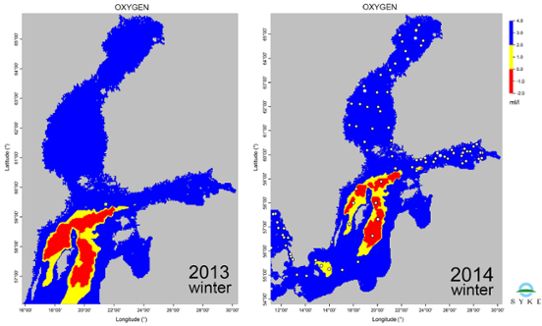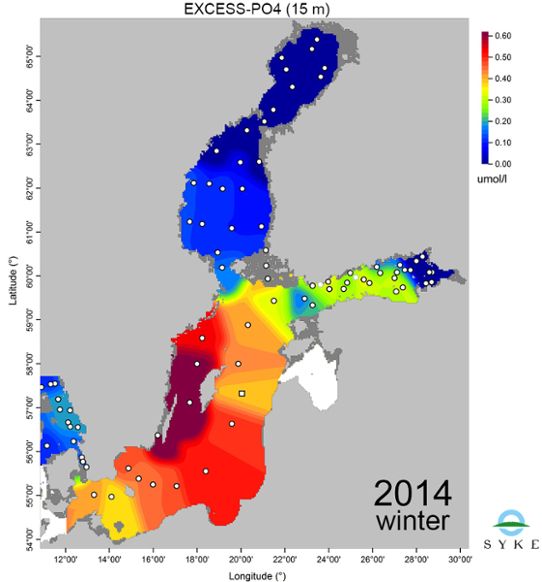R/V Aranda, the research vessel of Finnish Environmental Institute SYKE has during the winter 2014 monitored the environmental status of the Baltic Sea on an area that is significantly larger compared with previous years, as a result of co-operation with the Swedish Meteorological and Hydrological Institute, SMHI. The monitoring covered the whole area of the Baltic Sea.
- We are very satisfied with the co-operation with SYKE. We are looking forward to a continued good co-operation and thereby further improved marine monitoring, says Mikael Krysell, Head of Laboratory at SMHI in Gothenburg.
According to the Co-operation Agreement between SYKE and SMHI signed last year, a joint winter monitoring cruise was carried out as a combined effort on board research vessel Aranda between 22nd January and 13th February 2014. Prior to this, a specific Gulf of Finland cruise was carried out from 13th to 18th January, as a first monitoring cruise of the Finnish-Estonian-Russian Gulf of Finland Year 2014.
These efforts resulted in a data set giving a comprehensive view of the environmental status of the entire Baltic Sea in mid-winter 2014 (fig. 1).

Deep water oxygen conditions are still poor - storms have improved conditions at 50-80 m depth
Effects of the stormy early winter can be detected as a deepening of the mixed surface layer and flattening of the halocline compared with conditions in winter 2013 in the Baltic Proper (fig. 4). This mixing has improved the oxygen situation in the upper halocline waters of the Baltic Proper (figs. 2,3). However, deep water oxygen conditions of the Baltic Proper are still very poor and hydrogen sulphide was measured below ca. 100 meter depth. A mass of saline water seems to be flowing from the Bornholm basin towards the Gotland basin (fig. 4). This is probably caused by exceptional storms over Denmark in November-December 2013.
Inflows of saline water into the Baltic Sea trough the Sound have occured during late 2013 and in the beginning of 2014. During the period from late October to early November there was an inflow trough the Sound of approximately 40 km3. During December there was two minor inflows, one of 20 km3 and one of 10 km3. During February 2014 an inflow of about 30 km3 has taken place.
The magnitude of these inflows was not large enough to influence the deepestr parts of the central Baltic Proper. However, effects will be seen in the southernmost Baltic Sea in the Arkona and Bornholm Basins.
Somewhat increased deep water salinities in the Bothnian Sea indicate that water from the upper strata of the halocline have spilled from the Baltic Proper over the Åland Sea sill, reaching the Gulf of Bothnia. This has caused a slight decrease in deep water oxygen content in the Bothnian Sea compared with 2013 (fig. 3)



Elevated surface layer phosphorus in the Baltic Proper and the Bothnian Sea
There are some notable differences in nutrient concentrations between winters 2013 and 2014. The most important is the increase of phosphorus, especially in the surface layer of the Baltic Proper, but also in the Bothnian Sea (fig. 5). Phosphorus concentrations in the easternmost Gulf of Finland were somewhat lower than in the middle part of the Gulf, indicating an effect of the water protection measures made in Russia in recent years.
This increase of phosphorus in the Baltic Proper can most probably be attributed to strong mixing of upper halocline water with the surface water layers as shown by the changes in vertical salinity distributions between the two winters. The accumulation of phosphorus in the deep waters below the halocline is resulting from poor sediment phosphorus retention capacity and release of phosphorus under anoxic conditions, the so called internal loading.
Nitrogen levels in 2014 were somewhat lower than in the previous year in the Baltic Proper and in the Bothnian Sea (fig. 6). Along with increased phosphorus concentrations in the same period this results in elevated estimates of excess phosphorus in winter 2014 (fig. 7), which may increase the risk of blue-green algal blooms in these sea areas in the summer of 2014 as compared with the previous summer.



Oxygen conditions in the Bornholm Basin declined
The oxygen conditions in the Bornholm Basin near the southernmost part of Sweden had declined compared with the winter of 2013, and the oxygen concentrations were at critical levels (below 2 ml/l) in the bottom water.
In the Kattegat and the Skagerrak, the salinity in the surface water was much lower than normal, due to the effect of the outward flux of Baltic Sea water. The thermocline and halocline were found at 10-20 metres depth. In the central Skagerrak unusually high silicate levels were observed, which is also due to the outward flux of Baltic Sea water. The mapping of nutrients (phosphorus and nitrogen) in the Kattegat showed fairly uniform conditions and an overall normal situation.
For more information, please contact:
Juha Flinkman, HRD Manager, SYKE's Marine Researche Centre
Tel. +358 295 251 115
firstname.lastname@environment.fi
Mikael Krysell, Head of Laboratory, SMHI
Tel +46 31 751 8954
firstname.lastname@smhi.se